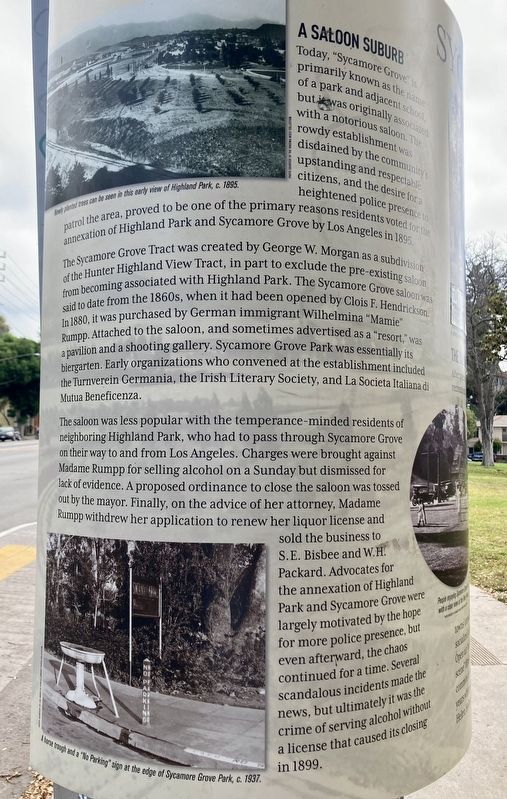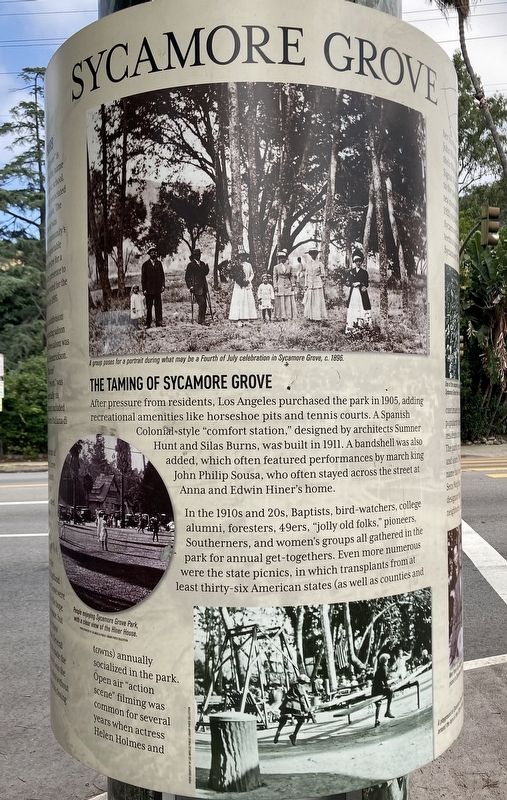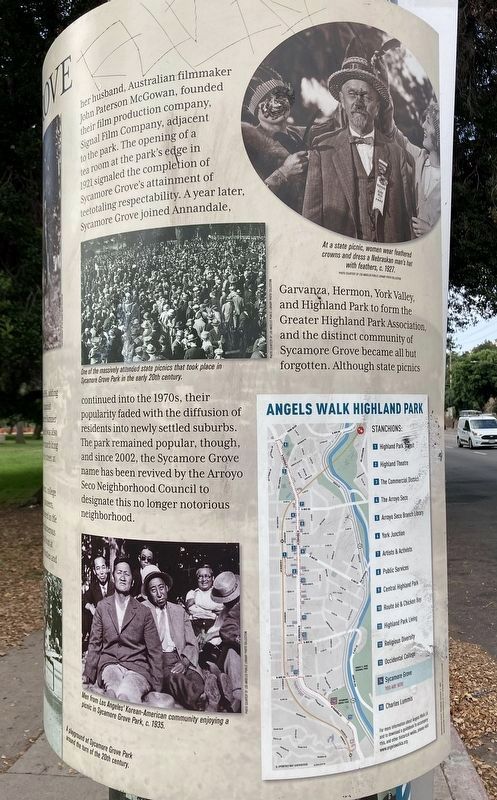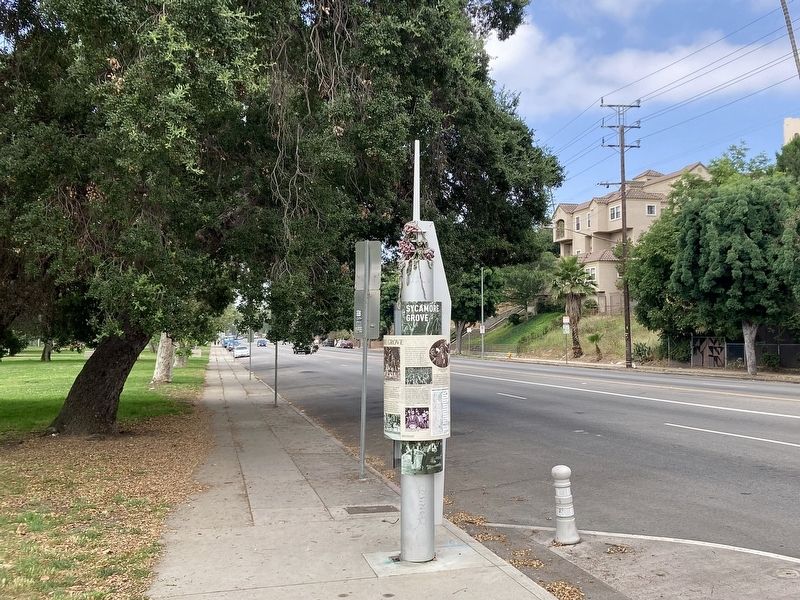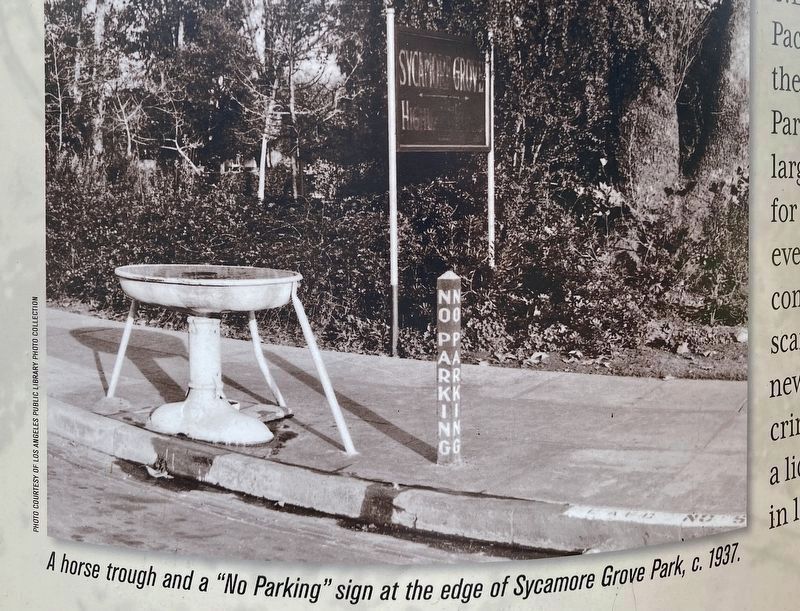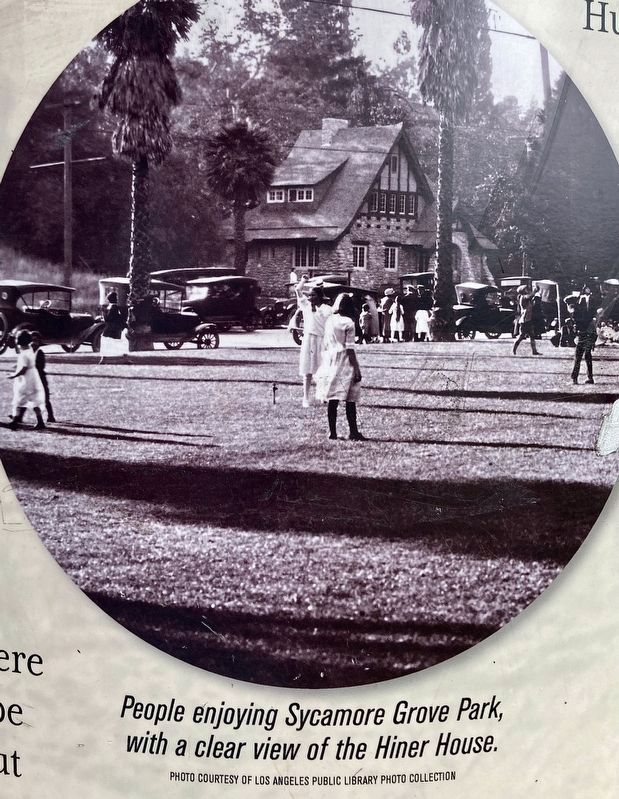Highland Park in Los Angeles in Los Angeles County, California — The American West (Pacific Coastal)
Sycamore Grove
A Saloon Suburb
Today, "Sycamore Grove" is primarily known as the name of a park and adjacent school, but was originally associated with a notorious saloon. The rowdy establishment was disdained by the community’s upstanding and respectable citizens, and the desire for heightened police presence to patrol the area, proved to be one of the primary reasons residents voted for the annexation of Highland Park and Sycamore Grove by Los Angeles in 1895.
The Sycamore Grove Tract was created by George W. Morgan as a subdivision of the Hunter Highland View Tract, in part to exclude the pre-existing saloon from becoming associated with Highland Park. The Sycamore Grove saloon was said to date from the 1860s, when it had been opened by Clois F. Hendrickson. In 1880, it was purchased by German immigrant Wilhelmina "Mamie" Rumpp. Attached to the saloon, and sometimes advertised as a "resort," was a pavilion and a shooting gallery. Sycamore Grove Park was essentially its biergarten. Early organizations who convened at the establishment included the Turnverein Germania, the Irish Literary Society, and La Societa Italiana di Mutua Beneficenza.
The saloon was less popular with the temperance-minded residents of neighboring Highland Park, who had to pass through Sycamore Grove on their way to and from Los Angeles. Charges were brought against Madame Rumpp for selling alcohol on a Sunday but dismissed for lack of evidence. A proposed ordinance to close the saloon was tossed out by the mayor. Finally, on the advice of her attorney, Madame Rumpp withdrew her application to renew her liquor license and sold the business to S.E. Bisbee and W.H. Packard. Advocates for the annexation of Highland Park and Sycamore Grove were largely motivated by the hope for more police presence, but even afterward, the chaos continued for a time. Several scandalous incidents made the news, but ultimately it was the crime of serving alcohol without a license that caused its closing in 1899.
The Taming of Sycamore Grove
After pressure from residents, Los Angeles purchased the park in 1905, adding recreational amenities like horseshoe pits and tennis courts. A Spanish Colonial style "comfort station," designed by architects Sumner Hunt and Silas Burns, was built in 1911. A bandshell was also added, which often featured performances by march king John Philip Sousa, who often stayed across the street at Anna and Edwin Hiner's home.
In the 1910s and 20s, Baptists, bird-watchers, college alumni, foresters, 49ers, "jolly old folks," pioneers, Southerners, and women's groups all gathered in the park for annual get-togethers. Even more numerous were the state picnics, in which transplants from at least thirty-six American states (as well as counties and towns) annually socialized in the park. Open air "action scene" filming was common for several years when actress Helen Holmes and her husband, Australian filmmaker John Paterson McGowan, founded their film production company, Signal Film Company, adjacent to the park. The opening of a tea room at the park's edge in 1921 signaled the completion of Sycamore Grove's attainment of teetotaling respectability. A year later, Sycamore Grove joined Annandale, Garvanza, Hermon, York Valley, and Highland Park to form the Greater Highland Park Association, and the distinct community of Sycamore Grove became all but forgotten. Although state picnics continued into the 1970s, their popularity faded with the diffusion of residents into newly settled suburbs. The park remained popular, though, and since 2002, the Sycamore Grove name has been revived by the Arroyo Seco Neighborhood Council to designate this no longer notorious neighborhood.
Erected by City of Los Angeles.
Topics. This historical marker is listed in these topic lists: Architecture • Entertainment • Parks & Recreational Areas. A significant historical year for this entry is 1895.
Location. 34° 6.097′ N, 118° 12.19′ W. Marker is in Los Angeles, California, in Los Angeles County. It is in Highland Park. Marker is on Figueroa Street near Sycamore Terrace, on the right when traveling north. Touch for map. Marker is at or near this postal address: 4755 N Figueroa St, Los Angeles CA 90042, United States of America. Touch for directions.
Other nearby markers. At least 8 other markers are within walking distance of this marker. Hiner House and Sousa Nook (a few steps from this marker); Charles Lummis (about 700 feet away, measured in a direct line); Southwest Museum (approx. 0.2 miles away); Mary P. Field House (approx. 0.2 miles away); Herivel House (approx. ¼ mile away); Occidental College (approx. ¼ mile away); Ziegler Estate (approx. ¼ mile away); Highland Park Living (approx. half a mile away). Touch for a list and map of all markers in Los Angeles.
Also see . . . Angels Walk L.A. Self-guided walking tours of historic neighborhoods in Los Angeles. The Sycamore Grove marker is part of the Highland Park walk. (Submitted on July 19, 2023.)
Credits. This page was last revised on July 19, 2023. It was originally submitted on July 19, 2023, by Craig Baker of Sylmar, California. This page has been viewed 121 times since then and 62 times this year. Photos: 1, 2, 3, 4, 5, 6. submitted on July 19, 2023, by Craig Baker of Sylmar, California.
